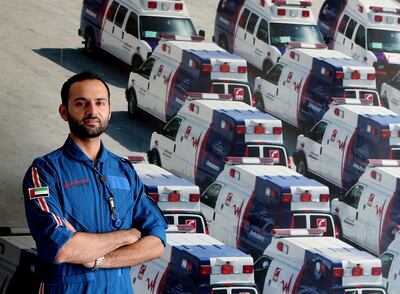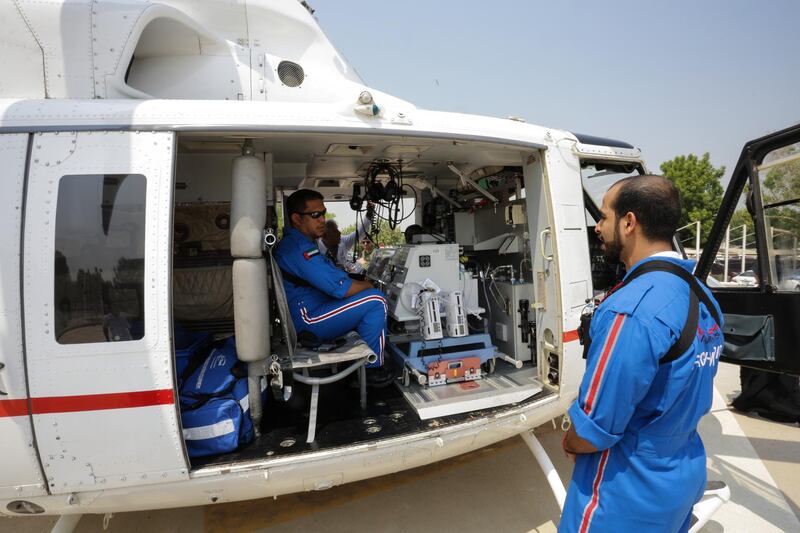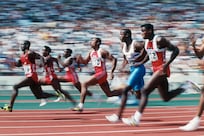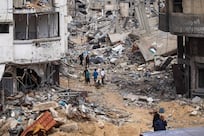Whether it's an accident on a mountain, a fall in a remote area or roads clogged with traffic after a crash, it's up to Majid Mohammed Al Zarooni and his team of air paramedics to give them a chance of survival.
His team are on duty around the clock to make sure medics can reach those in need - wherever they are.
Mr Al Zarooni, head of the air wing ambulance division at Dubai Corporation for Ambulance Services, attends about 130 incidents each year, from major road crashes to people stuck on mountains, and said that often the job is about speed.
“Our main task is to reach an accident victim at high speed, as paramedics at an ambulance vehicle might be obstructed by traffic or long distance,” said the 31-year-old Emirati.
“Our job is completely different from working in a well-lit emergency department. There are 13 paramedics working in the air wing ambulance division who are always on call. "We can be treating a patient involved in a car accident, trapped in mountains, or rescuing a drowning swimmer. During such accidents, we collaborate with paramedics, police or firefighters.”

Dealing with incidents involving children are the most difficult for Mr Al Zarooni.
“At the beginning of my career, dealing with patients and accident victims was heartbreaking,” he said. “Now, I manage to differentiate between my work and personal life but, when it comes to dealing with situations where children are affected, it is still heartbreaking.”
Mr Al Zarooni, who studied as an emergency medical technician at the Higher Colleges of Technology in 2004, said his team airlifted 92 people involved in major accidents last year.
When he started his paramedic training, it was a new subject in the Gulf. He learnt his trade in ambulances on the ground for two years after graduating before becoming a supervisor in 2010. Three years later he signed up to become the head of the air wing ambulance division.
Mr Al Zarooni has countless stories of lives saved. One such emergency was of a 16-year-old boy who had suffered a major brain trauma and doctors at Al Dhaid Hospital said he was already brain dead.
“I managed to get documents to authorise airlifting the boy to Rashid Hospital. Doctors said that the young Emirati boy was brain dead and he won’t be saved even if he was transferred to Rashid Hospital,” he said.
“However, we got him there. A week later I contacted the relative of the boy to see what happened and they told me that his health was much better and he would go back to school.
“This story shows that any patient has a great chance of survival.”
In another incident, a woman had left her home in the mountainous Hatta area to collect honey. Hours went by with no contract and her family reported her missing.
“We received a report about a woman in her 60s who didn’t return home,” Mr Al Zarooni said. “A helicopter and team from the air wing ambulance division were sent to locate the woman and they found her stuck in a mountain in Hatta.
“Apparently, she fell and twisted her ankle and couldn’t walk back home. First aid was administered and the Emirati woman was rescued and transferred to a hospital.”
In addition to having a head for heights and being ready to face any challenge, air wing paramedics have to be skilled in administering first aid.
The team are able to carry out medical treatments, interpret electrocardiograms (EKGs), which are used to monitor heart function and treat heart arrhythmia, and use other complex equipment such as ventilators and infusion pumps.
Bashair Abdel Rahman, a 27-year-old paramedic, has been in the job for five years and feels she is making a difference.
“I studied paramedic studies and received training at the Higher Colleges of Technology before going to England to continue my master’s degree in health policy," she said.
“I am driven by a challenge and I want to prove that women can perform well in this field. Also, we serve the community."
Mr Al Zarooni added that the job has its ups and downs but, ultimately, it is rewarding being able to help people when they are at their most vulnerable.
“Our job is challenging but it’s very rewarding. You are giving a person going through a major accident and might be injured a much better chance of survival,” he said.






